Although still quite young, (CNN, the granddaddy of the group, is just 26 years old) cable news is no longer the new kid on the information-delivery block, but rather a rapidly maturing medium whose overall audience appears to be leveling off.
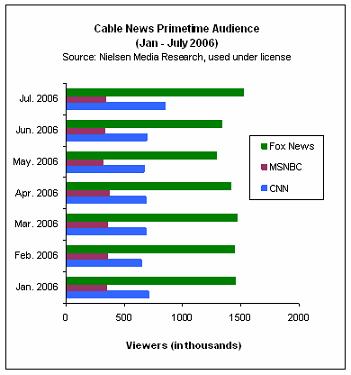
Nielsen Media numbers indicate that ratings for all three cable news channels remained steady for the first half of the year. And a new media consumption survey by the Pew Research Center For The People and The Press found that the percentage of adults who say they regularly watch cable news dropped from 38% in 2004 – a national election year – to 34% this year. In another sign of potential trouble for cable news outlets – which generally benefit from major news events – the current Middle East crisis hasn’t generated noticeable spikes in their primetime audiences.
Still in the heated cable news ratings wars, the big winner continues to be the Fox News Channel, which generates more primetime viewers than CNN and MSNBC combined.
In our sixth roundtable, part of PEJ’s series of nine roundtables with industry experts on the future of the news media, experts on Cable TV news share their thoughts on the direction of the industry. And there is disagreement about that future. While some of our analysts say the industry is poised to adapt to the changing news consumer, others seem convinced that dramatic innovations are necessary.
The panelists for this roundtable were:
- Rick Kaplan, former President and General Manager, MSNBC
- George Niesen, VP & Managing Editor, Kagan Research (an independent media research firm that provides economic, financial and technical analysis for the media & communications industries).
- David Payne, Senior VP, CNN News Services & General Manager, CNN.com
- Judy Woodruff, Special Correspondent for MacNeil/Lehrer Productions
Note: Fox News declined to participate in the discussion
1. If there were one thing you could change about the cable TV news industry, what would it be?
Rick Kaplan: If there was one thing I could do, I would like to give everyone a “patience pill.” In a perfect world, you could just take a program and work with the program, make it better, make it deeper and make it smarter, and when those things get done and it’s on the air, you should be allowed the patience to stick with it. “60 Minutes,” for example, took five or six years to gain a significant audience.
[I would change]
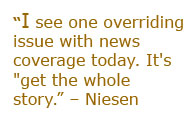
George Niesen : I see one overriding issue with news coverage today. It’s “get the whole story.” Unfortunately (and intentions aside) that’s impossible with instant journalism. Even more unfortunately, the responsibility for “getting the whole story” has devolved from the journalist to the consumer. And most unfortunately, few consumers have the time/resources/inclination to put together the whole story.
The real question is how to deal with the issue. The short and quick answer is “consumer education.” But it’s not an easy answer. It requires the combined efforts of the media, the schools and families. The media itself has failed us the most in this educational process. The media owes it to the public to make newsgathering and analysis as transparent a process as possible, especially in an age of instant journalism. We need to know not only what’s current, what’s old, what’s fact and what’s speculation but also what’s developing and what needs a follow-up. And then the media needs to follow up.
The good news is that great journalism is alive and well—even thriving—but one generally has to search alternative media to find it.
We need to adapt to, and make efficient and effective use of, new delivery methods. Technological change will only become faster and more inevitable. Consumers will want their news immediately. They will also (or at least should) want more depth. Effective media reach will come via directed, semi-push methods of news delivery—RSS is a potential example—that will provide the updates, the analysis and the varied viewpoints in-depth reporting requires. It’s about reporters staying on task and the delivery mechanisms ensuring the consumer sees that and receives the results of it.
David Payne: I would really like to see us do a better job of standardizing our ad units in order to capture a larger share of the marketplace vis-à-vis the portals. All the major news and content sites have different creative standards, animation times, and rich media guidelines for things like expandability and host-initiated audio and video. A common set of standards that would make it easier for agencies and advertisers to buy our products.
2. Content analysis suggest that cable stories, with their emphasis on being live, contain fewer sources, less depth, fewer points of view and less information than other kinds of TV reporting and other kinds of media. Is this inevitable because of the instant nature of cable or do you see this as a competitive disadvantage?
[It is]
Rick Kaplan: It’s only inevitable if you take the view that cable news and television journalism in general is something that you should watch as a hobby, as something that isn’t important, something that is more entertainment. I don’t think people are doing it as well as they ought to be and we’re moving away from it. When stories are evolving and live, that’s one thing and you have to cover them live. There are other stories that are much better off if they have a thought out, researched, reported core, if you will. Then, you can be live at the top or the bottom, or somewhere in between, in order to reflect questions and answers you want to cover. Bottom line, however, this is definitely an issue that we have to deal with as an industry and a profession.
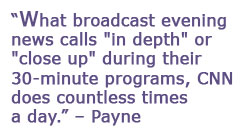
David Payne: While there might be a perception that cable news is less in depth, remember that cable is programming for 24 hours a day; not just 30 minutes a day. What broadcast evening news calls “in depth” or “close up” during their 30-minute programs, CNN does countless times a day. Additionally, the reports and packages that appear across CNN’s networks actually are more in depth than they ever have been. And time and time again, CNN consistently wins awards for our long form documentary and investigative work. The claim that there isn’t a deeper context in cable news — we just don’t buy that at CNN.
George Niesen : It is inevitable and it should be a competitive disadvantage but only the consumer can dictate that (and you know where that will end up). New delivery platforms (e.g. the Net) will be even more instant, but I have hopes those platforms will provide far better news, for several reasons. For one, you have nearly limitless sources for news and follow-up. Two, it’s cheap, which allows for a huge diversity of opinions, viewpoints, coverage, news providers, etc. Three, it’s easily updated, permitting depth and effective follow-up of stories. Despite the instant nature of new platforms, it will be much easier for the consumer to get, eventually, the whole story. Nonetheless, a lot of responsibility remains with the consumer.
3. Will the audience for cable news continue to grow or do you think it is hitting a ceiling as penetration growth ends? If it has peaked, what should the news channels do?
[cable]
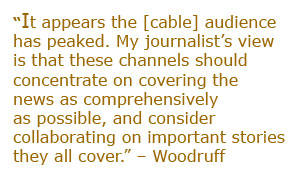
My journalist’s view is that these channels should concentrate on covering the news as comprehensively as possible, and consider collaborating on important stories they all cover. The audiences would benefit from more resources spent on more important stories, rather than worrying so much about being first on developments.
Rick Kaplan: Cable is the ultimate reality show and as long as it stays compelling, interesting and useful as can be, the audience will continue to grow. It’s ludicrous to think that during a day there are only a million people available to watch cable news, when there are 80 million people available to watch cable. It goes back to my first point that if news outlets don’t start digging down and giving people the information that truly is news, they won’t grow. It requires considering what the audiences need, what they are able to get, what you are able to provide and you can’t play the lowest common denominator in this because it’s not going to satisfy.
David Payne: Especially since September 11, there has been a consistent and continual increase in news viewing on cable versus broadcast channels. We see enormous potential for cable news share to continue to increase, and we expect that trend to carry on.
[The]
4. Content analysis also suggests stark differences among the three channels in both style and content. How do you see this playing out in the long term? Will each channel become more of niche outlet, appealing to different types of news viewers?
Rick Kaplan: Networks need to grow, whether you’re CNN, FOX, or MSNBC. The point is, these networks are living, breathing organisms which means they grow, they evolve. If you let them
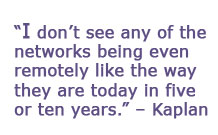
grow, and evolve, and mature and change and move with the times and rest, you will have a better thing. I don’t see any of the networks being even remotely like the way they are today in five or ten years. And how they will evolve, I don’t know, but if they don’t evolve you won’t see them at all.
David Payne: We can only speak from CNN’s perspective on this point. CNN’s content is whatever the news is; and we will continue to stay the course with that focus. With the largest reach and highest diversity of audience than of any television news organization in the world, we’re happy with our “niche” audience.
George Niesen : The great paradox of our existence today is that even as the people of the world become ever more interconnected and interdependent, our cultures are rapidly fragmenting. But those are the kinds and ranges of niches we are all playing into. News providers will have to fragment themselves; they’ll have to find niches and fill them.
5. One broad trend we sense in the media culture is the paradox of more outlets covering fewer stories. As the audiences for particular news outlets shrink, newsroom resources are then reduced, but these outlets still feel compelled to cover the big events of the day. The result is more outlets covering those same “big” events and fewer are covering much beyond that as much as they once did. How do you view this trend?
George Niesen : I see the trend as not much of an issue in the medium-to-long term, as even more outlets (to include alternative media and even individuals) cover even more stories. The media conglomerates, to survive, will have to fragment themselves to serve an ever-increasing number of niches and they’ll have to revise their business models appropriately. On big stories the key will be cooperation rather than competition, as any number of niche providers will have to come together to deal with them.
[but]
Rick Kaplan: The problem isn’t that it’s too many covering too few events. The
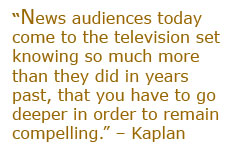
problem is that news audiences today come to the television set knowing so much more than they did in years past, that you have to go deeper in order to remain compelling. In the old days when Walter Cronkite or Peter Jennings or Tom Brokaw or Dan Rather came on the air, whatever they said after “good evening” was usually news to people. Now, it’s like ‘I know Martha Stewart was convicted, I know there were demonstrations for immigration… I know these stories’. What they don’t know, however, are more details about the stories. It’s not that they’re just covering too few events or just the big ones, it’s that they’re not going deeper than the surface headlines. It’s covering the event as the event. You need to get deeper, you need to get more facets out of a story – that’s what they’re not doing.
David Payne: Audiences for news are not shrinking; they’re just migrating into different usage patterns. So while you see, for example, lower subscribers for print news, that audience is not “going away” per se, it’s just moving to digital platforms, where the growth and upside potential are virtually unlimited. Every local newspaper, for example, now has the potential to be a truly global medium. The trick is getting the right resources in the right places to capture what is, in fact, a larger audience for news than ever before.
6. How big of a threat is online news to the cable news channels? Some have argued that the Internet can offer the immediacy of cable without all the repetition, which means cable could actually suffer fairly substantially. How will they compare with older media, such as networks and newspaper, who will be able to offer instant video and audio if they want?
David Payne : The online divisions of cable news and other media organizations should be completely complementary to their parents. At CNN, online news isn’t viewed as a threat – it’s an extraordinary opportunity to reach a larger audience – particularly an at-work audience — that gives us more reach, more depth and more sales.
We have a great market position because CNN has always been organized as one news organization providing each network and platform with access to everything that CNN’s global newsgathering operation has to offer. CNN shares assets across all of its platforms. The more time a news organization spends dividing up its workforce into traditional and digital media arms, the longer our competitive advantage will last.
Rick Kaplan: I don’t think online news is a threat. Where it is all moving is some kind of visual model in which streaming video and all the rest is married to what you can do in writing. You will be able to accomplish both simultaneously. I think this convergence, in the end, is massive, and I don’t think there will be a computer screen or television screen like we have now. I think there will be one screen that combines them both. Again, I don’t think it’s a threat unless you want to stand back and not change anything. That would be a threat to your survival.
Judy Woodruff : Online news is already a threat to cable channels and other outlets. Many young people – and even some older ones! – already turn to the internet for news. The interesting question is will they turn to established sites, like The New York Times and NBC news, or will they turn to Yahoo and Google, for a compilation of stories, and eventually, perhaps, their own reporting (as Yahoo is already doing with Kevin Sites.)
George Niesen : Of course, cable is threatened by the Internet, as it should be. Cable news organizations will have to compete on the same playing field—with instant video and audio—as networks and newspapers (and Internet content aggregators). News by appointment ( 10 pm) is becoming increasingly irrelevant (which has forced the networks’ hand sooner than cable’s). And in the mid-term future, breaking news will be much better served by alternative delivery methods than by cable.
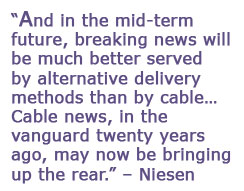
The critical factor is follow-up and depth—not something either network or cable TV news has ever been noted for anyway. The Net is a huge threat in that it will be able to provide the news people want when and where they want it and with the depth of coverage they want (ironically a strong factor for newspapers in this electronic age). Cable news, in the vanguard twenty years ago, may now be bringing up the rear.
One final note – one major unconsidered factor here is regulation and legislation and the effect that will have on media and new media especially. Broadcast TV is heavily regulated vs. cable. Old media would like to see new media comparably regulated. New media wants a free hand. Throw in politics and the mix may get interesting over time.
7. How much confidence do you have that traditional mainstream media organizations in general will survive and thrive in the transition to the Internet?
Judy Woodruff : I wish I had more. It depends on how agile and innovative they are as this transition takes place. If they can transform themselves into multi-media, multi-tasking news gathering machines, and find a business model that permits them to make a healthy return – then they can survive. But this is no simple trick.
Rick Kaplan: I have total confidence that they will survive. No matter what happens in the future it’s the major media outlets that have the content, the libraries and the structure and, they’re smart – they won’t sit still. It’s narrow-minded and just plain short sighted to think that mainstream media organizations are not going to evolve and that they’re not going to develop.
[Do]
George Niesen : Money talks, and mainstream media conglomerates are at least resourceful, if not particularly agile. They’ll find a way to maintain their relevance.
If you would like to offer your own thoughts on the future of cable TV news, please email us at mail@www.pewresearch.org/pewresearch-org/journalism. We will then compile and post a selection of responses.




